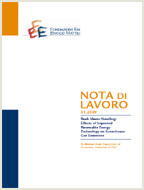The Oil price-Macroeconomy Relationship since the Mid- 1980s: A global perspective

03.05.2012
Claudio Morana
C22, E32, G12
Oil Price, Oil Price-Macroeconomy Relationship, Macro-finance Interface, International Business Cycle, Factor Vector Autoregressive Models
Energy: Resources and Markets
Giuseppe Sammarco
In this paper the oil price-macroeconomy relationship is investigated from a global perspective, by means of a large scale macro-financial-econometric model. In addition to real activity, fiscal and monetary policy responses and labor and financial markets are considered as well. We find that oil market shocks would have contributed to slowing down economic growth since the first Persian Gulf War episode. Among oil market shocks, supply side disturbances were the largest contributor to macro-financial fluctuations, accounting for up to 12% of real activity variance. The latter shocks would have exercised recessionary effects during the first and second Persian Gulf War and 2008 oil price episodes; preferences, speculative and volatility shocks would have also contributed to exacerbate the recessionary episodes. As long as oil supply will keep expanding at a lower pace than required by demand conditions, a recessionary bias, determined by higher and more uncertain real oil prices, may then be expected to persist also in the near future.
***
Suggested citation: C. Morana, The Oil price-Macroeconomy Relationship since the Mid- 1980s: A global perspective, The Quarterly Journal of the IAEE’s Energy Economics Education Foundation, Volume 34, Number 3, http://dx.doi.org/10.5547/01956574.34.3.8
